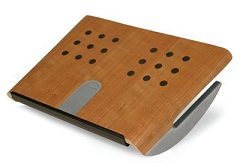Why Treadmill Desk Users Need to Stretch Like Professional Athletes

It is vitally important to stretch your legs, calves, ankles and lower back frequently when using a treadmill desk. As great as the benefits of raising your basal metabolic rate are, doing so requires using your leg and back muscles a lot more than you are probably used to. The fact that the pace of walking is set by a machine and the terrain is consistently even leads to more muscle strain than actually walking in the woods or around the neighborhood. Think of it as something that can produce Repetitive Motion Syndrome on a larger muscle scale.
It is best to stretch before mounting the treadmill, to take frequent stretch breaks (every hour or so), and most importantly to stretch at the end of every session. Let the keyboard and mouse go every so often and swing your arms back and forth, twisting your torso. This will help hydrate the discs between your spinal vertebrae, keeping them healthy and limber.
You can also do some stretching while walking without stopping the treadmill. From time to time, do some shoulder rolls and other upper body and neck exercises, just as you would do if you were sitting down and computing or sitting in an airplane seat for a long time. Or put in your earbuds and move to some good music as a fun way to break out of the repetitive walking stride. Think that’s absurd? Just check out this breathtaking OK Go treadmill dance video.
Here’s another stretching idea for those with the coordination to do it (some people have it, and we have to admit some people just don’t). Be sure you have someone next to you for safety check the first time you try this. Set the treadmill speed down to 1.0 mph or slower and then walk backwards for a bit. This is an ideal “stretch” to perform while on the phone, talking to a colleague or otherwise not needing to look at the screen.
The most important thing is to make stretching a habit. You can use this great stretching guide to get you started. Set reminders in your calendar program or use a kitchen timer or your smartphone timer to ring off every hour while you’re walking. Another great way to do this is to use a (free) “Pomodoro Timer” software app.

Physical therapists often recommend getting a good soft-tissue stretch as well with the aid of an inexpensive, handy device like the Tiger Tail (our #1 choice), The Stick (great for travel) or even a simple foam roller. Doing so will reduce muscle soreness, stiffness and pain, while accelerating muscle recovery and dispersing the effects of lactic acid following activity.
 Since most of us are guilty of not stretching enough after long sessions on the treadmill, one of our favorite devices that we recommend to friends all the time is the Humanscale Foot Rest. Unlike other footrests and foot rockers this one is properly designed to rotate right where your ankle rotates. We keep these under our sitting desks and gently rock back and forth on them after long sessions on the treadmill. It feels amazing on the feet and calves, and keeps them loose and limber so that you can have even longer treadmill sessions without causing the small muscles in the foot or any of the larger leg muscles to suddenly seize up 20 minutes after ending your treadmill session.
Since most of us are guilty of not stretching enough after long sessions on the treadmill, one of our favorite devices that we recommend to friends all the time is the Humanscale Foot Rest. Unlike other footrests and foot rockers this one is properly designed to rotate right where your ankle rotates. We keep these under our sitting desks and gently rock back and forth on them after long sessions on the treadmill. It feels amazing on the feet and calves, and keeps them loose and limber so that you can have even longer treadmill sessions without causing the small muscles in the foot or any of the larger leg muscles to suddenly seize up 20 minutes after ending your treadmill session.
If you want to make sure a treadmill will work for you, you should read our article on guidance to see how you can test one out for yourself.

0 Comments
Leave a response >